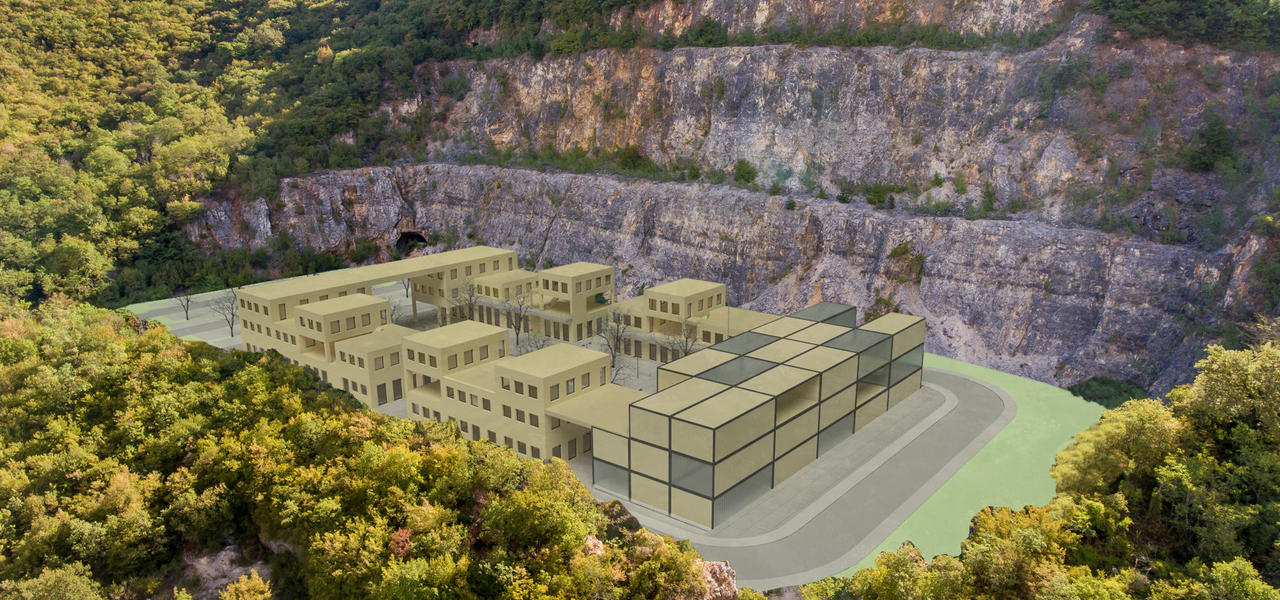
Memorial center Karlota in Raša
Status:
Project not implemented
Year of designing:
2017.
Program:
Public, Culture
Location:
Spatial scope
interior 2,517.00 m2, exterior 4,768.00 m2
Investor:
Author:
Arhitektonsko-građevinski atelje d.o.o.
Project team:
Arsen Čupev, Luka Ilić, Vladi Bralić
Additional projects:
Programme authors: Eleonora Vlašić, Nenad Čaklić
Every time period's zeitgeist gives the main ideological frame from which architecture and urbanism programming platforms are developed, and can range from conservative and retrograde to advanced and emancipatory and even utopian endeavors.
In closed and repressive systems, instead of ideological pluralism, ideological monism is always governed by state totalitarian rule which is often, though not always, reflected in the architecture and urbanism of the XX. century through use of the academic and traditional stylistic forms created in some other space and time coordinates by rejecting a modern formative heritage. Also, totalitarian systems of architecture and urbanism were often characterized by the construction of overly monumental structures and most often overly monumental state buildings that glorified the totalitarian regime. All this was fully achieved in Nazi Germany under the rule of A. Hitler and during Bolshevism in the USSR under J.V. Stalin.
n the XX. century, Istrian territory was also characterized by totalitarianism. Istria and other parts annexed by Italy were already influenced by the fascism of Mussolini's Italy from 1922 until 1943. In Yugoslavia under Tito's rule, between 1945 and 1948, and the conflict with the Informbiroom, socialism was adapted as a model of the regime the USSR practiced – a strict order and the first phase of communism, which was considerably less strict in the later period until 1990. But contrary to Germany or the USSR, on Croatian territory, including Istria, high-quality architectural and urban achievements were accomplished. Why is it so is not easy to understand even looking in retrospect, because various historical and cultural contributing factors that objectively represent that period's day-to-day life have to be taken into consideration. Top architectural achievements in Istria date from the period of Italian facism and can be spotted in the mining town Raša (Arsia), which was built as a project of the facist Italian government based on the work of architect Gustavo Pulitzer Finalija where, in an exceptional way, he synthesized the progressive idea of modern architecture and traditional expression.
For all these reasons, the location of the memorial center of European totalitarians was thoroughly chosen to be in Istria and precisely in the area of Raša Municipality. Istria is the European region that has spent its longest period under totalitarian regimes. On the other hand, unlike all the Istrian towns and settlements, Raša was built as an industrial town near the coal mine, its fate was very closely tied to fascism and communism - the two totalitarian regimes that marked the 20th century in Europe.
In the spatial sense, the site of the abandoned Karlota quarry proved to be an optimal solution for the accommodation of a memorial center for several reasons: the quarry is located near Raša, the area is elevated and has a nice view of the historical structures of the city, the plateau in front of the rock cut section has a considerable surface area of approximately P = 3.1 ha which fully meets the conditions for the accommodation of such complexes and associated traffic routes, the memorial center can easily be connected to the Raša mine pit and included in a more detailed reconstruction project of the whole mining complex of Labin, Karlota quarry is one of the largest Istrian quarries with an abandoned surface that requires reconstruction.
It should be emphasized once again that the Memorial Center of European totalitarism is invisioned as a cultural and commercial complex within which a symbiosis of the cultural and commercial sectors takes place. Under a unique architectural cover, cultural and educational contents devoted to the study and presentation of European totalitarian regimes, as well as a variety of commercial content, would be located. In such a center, a highly aesthetic synergy of cultural and educational offerings should be realized, but at the same time quality commercial offers such as shopping, gastronomy and design.
Other projects from the category Culture:
- Astronomy Centre
- National Reading Room
- The Rijeka Synagogue
- Memorial crane
- A Light Sign for Rijeka
- Placement of the Sculpture by V. Radoičić
- Zrinski Castle - an Exhibition
- Apage Satanas!
- A Suggestion for Building a Romolo Venucci Gallery
- Julije Klović Croata - a Memorial Collection
- Krčki Tanac – A Memorial for the Victims and the Fighters of the National Liberation War
- Exhibiting a Sculpture of N. Bilić
- Crystal Cube of Serenity for Tin Ujević
- Interpretacijski centar Ronjgi











